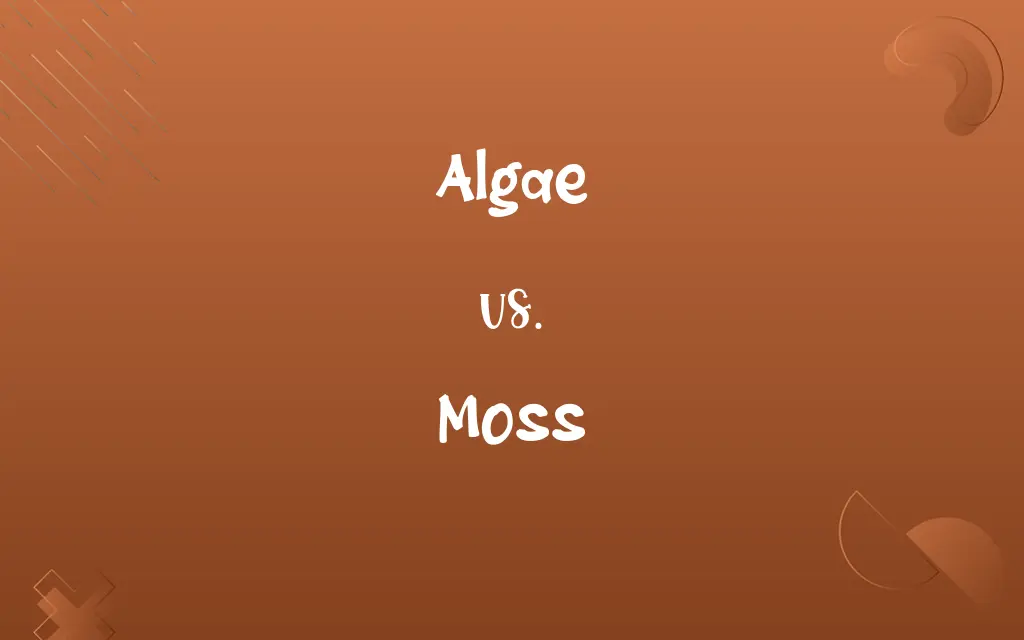Algae vs. Moss: Know the Difference

By Shumaila Saeed || Published on January 7, 2024
Algae are simple, primarily aquatic, photosynthetic organisms, while mosses are non-vascular land plants that typically grow in dense green clumps.

Key Differences
Algae are predominantly aquatic, thriving in both freshwater and marine environments and can also be found on land in moist conditions. Mosses, on the other hand, are terrestrial plants that grow in moist, shady locations, often covering forest floors and tree trunks.
Shumaila Saeed
Jan 07, 2024
Algae encompass a diverse group of photosynthetic organisms that are not necessarily closely related, ranging from single-celled forms to large seaweeds. Mosses belong to the Bryophyta division, characterized by their small, leafy structures and are more closely related to other land plants.
Shumaila Saeed
Jan 07, 2024
Algae reproduce through a variety of methods, including asexual reproduction and spores. Mosses reproduce using spores but also have a distinct alternation of generations, with a visible gametophyte stage and a smaller, attached sporophyte stage.
Shumaila Saeed
Jan 07, 2024
Algae lack the complex structures found in higher plants, such as roots, stems, and leaves. Mosses, although also non-vascular, have structures resembling leaves and stems and attach to surfaces with root-like filaments called rhizoids.
Shumaila Saeed
Jan 07, 2024
Algae play a crucial role in aquatic ecosystems, contributing significantly to oxygen production and serving as a primary food source. Mosses are important in terrestrial ecosystems, aiding in soil formation, moisture retention, and providing habitats for small organisms.
Shumaila Saeed
Jan 07, 2024
ADVERTISEMENT
Comparison Chart
Habitat
Mainly aquatic, some terrestrial species
Primarily terrestrial, in moist, shady areas
Shumaila Saeed
Jan 07, 2024
Biological Classification
Diverse group, from single-celled to seaweeds
Division Bryophyta, small leafy plants
Shumaila Saeed
Jan 07, 2024
Physical Structure
Lack true roots, stems, leaves
Have leaf-like structures, rhizoids
Shumaila Saeed
Jan 07, 2024
Ecological Role
Oxygen production, primary food source
Soil formation, moisture retention
Shumaila Saeed
Jan 07, 2024
ADVERTISEMENT
Algae and Moss Definitions
Algae
Simple, primarily aquatic photosynthetic organisms.
Algae are a key component of marine and freshwater ecosystems.
Shumaila Saeed
Dec 18, 2023
Moss
Reproduce using spores and have a two-stage life cycle.
Moss releases spores from the sporophyte to propagate.
Shumaila Saeed
Dec 18, 2023
Algae
Essential in producing oxygen and as a food source.
Algae contribute significantly to the Earth's oxygen production.
Shumaila Saeed
Dec 18, 2023
Moss
Small, non-vascular land plants in the division Bryophyta.
Moss often covers forest floors, giving them a green carpet-like appearance.
Shumaila Saeed
Dec 18, 2023
Algae
Range from microscopic phytoplankton to large seaweeds.
Kelp, a type of large brown algae, forms underwater forests.
Shumaila Saeed
Dec 18, 2023
ADVERTISEMENT
Moss
Lack true roots, instead using rhizoids to anchor.
Moss uses rhizoids to attach to rocks and tree bark.
Shumaila Saeed
Dec 18, 2023
Algae
Used in products like food supplements and biofuels.
Algae are cultivated for making biofuels and nutritional supplements.
Shumaila Saeed
Dec 18, 2023
Moss
Any of various green, usually small, nonvascular plants of the division Bryophyta, having leaflike structures arranged around the stem and spores borne in a capsule.
Shumaila Saeed
Dec 13, 2023
Algae
Can grow in diverse environments, including extreme conditions.
Algae can thrive in hot springs and polar ice.
Shumaila Saeed
Dec 18, 2023
Algae
Any of numerous photosynthetic organisms of aquatic or moist habitats, ranging in size from single-celled diatoms to large seaweeds such as kelp, and characterized by a lack of complex organs and tissues. Once classified within the plant kingdom, the algae are now considered to include several unrelated groups belonging to different kingdoms.
Shumaila Saeed
Dec 13, 2023
Moss
Any of various other unrelated plants having a similar appearance or manner of growth, such as Irish moss, Spanish moss, and the club mosses.
Shumaila Saeed
Dec 13, 2023
Moss
Any of various small, green, seedless plants growing on the ground or on the surfaces of trees, stones, etc.; now specifically, a plant of the phylum Bryophyta (formerly division Musci).
Shumaila Saeed
Dec 13, 2023
Algae
Primitive chlorophyll-containing mainly aquatic eukaryotic organisms lacking true stems and roots and leaves
Shumaila Saeed
Dec 13, 2023
Moss
(informal) Any alga, lichen, bryophyte, or other plant of seemingly simple structure.
Spanish moss
Irish moss
Club moss
Shumaila Saeed
Dec 13, 2023
Moss
(intransitive) To become covered with moss.
An oak whose boughs were mossed with age.
Shumaila Saeed
Dec 13, 2023
Moss
A cryptogamous plant of a cellular structure, with distinct stem and simple leaves. The fruit is a small capsule usually opening by an apical lid, and so discharging the spores. There are many species, collectively termed Musci, growing on the earth, on rocks, and trunks of trees, etc., and a few in running water.
Shumaila Saeed
Dec 13, 2023
Moss
A bog; a morass; a place containing peat; as, the mosses of the Scottish border.
Shumaila Saeed
Dec 13, 2023
Moss
To cover or overgrow with moss.
An oak whose boughs were mossed with age.
Shumaila Saeed
Dec 13, 2023
Moss
Grow in dense clumps or mats in damp, shady areas.
Moss grows on the north side of trees, where moisture is retained.
Shumaila Saeed
Dec 18, 2023
Moss
Important for soil stabilization and moisture retention.
Moss plays a crucial role in preventing soil erosion in forests.
Shumaila Saeed
Dec 18, 2023
Repeatedly Asked Queries
Do mosses need a lot of sunlight?
Mosses generally prefer shady conditions and can be damaged by too much sunlight.
Shumaila Saeed
Jan 07, 2024
Can algae be harmful to aquatic environments?
Yes, some types of algae can overgrow and create harmful algal blooms, depleting oxygen and releasing toxins into the water.
Shumaila Saeed
Jan 07, 2024
Are algae used in food production?
Yes, certain types of algae, such as spirulina and seaweed, are used as food sources and nutritional supplements.
Shumaila Saeed
Jan 07, 2024
Do algae have chlorophyll?
Yes, algae contain chlorophyll, a pigment that allows them to perform photosynthesis.
Shumaila Saeed
Jan 07, 2024
Can algae be beneficial for carbon dioxide (CO2) absorption?
Yes, algae can absorb CO2 from the atmosphere and are being explored for carbon capture and biofuel production.
Shumaila Saeed
Jan 07, 2024
Are algae single-celled or multicellular?
Algae can be both single-celled (microalgae) and multicellular (macroalgae or seaweeds), depending on the species.
Shumaila Saeed
Jan 07, 2024
Can algae live outside of water?
Yes, some algae species can survive on moist land surfaces.
Shumaila Saeed
Jan 07, 2024
Are mosses beneficial for soil erosion control?
Yes, mosses can help prevent soil erosion due to their ability to stabilize soil and retain moisture.
Shumaila Saeed
Jan 07, 2024
Do mosses have roots like other plants?
Mosses lack true roots; instead, they have rhizoids that anchor them to the substrate and absorb water and nutrients.
Shumaila Saeed
Jan 07, 2024
Are mosses used in horticulture or landscaping?
Yes, mosses are often used in horticulture and landscaping to create attractive, low-maintenance ground cover.
Shumaila Saeed
Jan 07, 2024
Are algae plants or animals?
Algae are neither true plants nor animals; they are a diverse group of photosynthetic organisms.
Shumaila Saeed
Jan 07, 2024
Are algae responsible for the green color in ponds and lakes?
Yes, the green color often seen in bodies of water is due to the presence of algae, specifically green algae.
Shumaila Saeed
Jan 07, 2024
Are mosses related to algae or ferns?
Mosses are not closely related to algae or ferns; they belong to a distinct group of plants called bryophytes.
Shumaila Saeed
Jan 07, 2024
Can mosses survive in harsh conditions?
Mosses are adaptable and can survive in extreme conditions, including deserts and Arctic tundra.
Shumaila Saeed
Jan 07, 2024
Do mosses require a lot of water to grow?
Mosses prefer moist environments but can tolerate periods of dryness and rehydrate when moisture is available.
Shumaila Saeed
Jan 07, 2024
Can mosses be harmful to trees or structures?
Mosses are generally not harmful to trees or structures; they simply grow on surfaces without causing damage.
Shumaila Saeed
Jan 07, 2024
Do mosses produce flowers or seeds?
Mosses reproduce via spores rather than flowers or seeds, making them distinct from flowering plants.
Shumaila Saeed
Jan 07, 2024
Share this page
Link for your blog / website
HTML
Link to share via messenger
About Author
Written by
Shumaila SaeedShumaila Saeed, an expert content creator with 6 years of experience, specializes in distilling complex topics into easily digestible comparisons, shining a light on the nuances that both inform and educate readers with clarity and accuracy.









































































